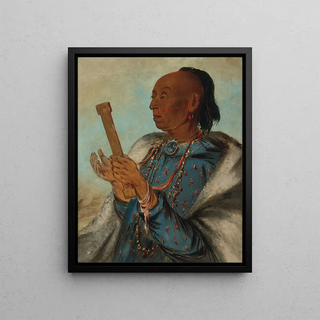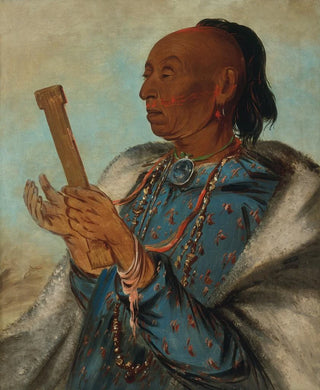Art print Ah-Tn-We-Tuck Cock Turkey répétant sa prière - George Catlin | Art print


View from behind

Frame (optional)
In the fascinating world of 19th-century American art, George Catlin stands out for his ability to capture the essence of Native American cultures. The art print of Ah-Tn-We-Tuck Cock Turkey repeating his prayer fits within this tradition, offering a poignant glimpse into the spirituality and rituals of indigenous peoples. Catlin, a true ethnographer, dedicated his career to documenting the lifestyles, traditions, and beliefs of the tribes he encountered. This painting, both vibrant and meaningful, evokes a moment of devotion and connection to nature, reflecting the depth of Native American rituals.
Style and uniqueness of the work
Catlin's work is characterized by a style that is both realistic and romantic. In the art print of Ah-Tn-We-Tuck Cock Turkey repeating his prayer, rich colors and meticulous details bring to life a scene imbued with spirituality. The choice of hues and the carefully orchestrated composition create an immersive atmosphere, inviting the viewer to feel the intensity of the moment. The artist does not merely reproduce an image; he manages to convey the emotion and depth of a sacred ritual. The facial expressions of the characters, as well as the posture of the individual at the center of the scene, reveal intimacy and a connection with the divine, characteristic of Catlin's works. This painting stands out for its ability to evoke universal feelings while remaining rooted in a specific cultural context.
The artist and his influence
George Catlin, born in 1796, is often regarded as one of the first artists to dedicate his work to the representation of Indigenous peoples of America. His passion for art and his commitment to preserving Native American cultures led him to undertake journeys across the continent, where he created numerous portraits and scenes of daily life. Catlin not only documented these declining cultures but also helped raise American public interest in the traditions and lifestyles of the tribes. His influence is felt in contemporary art, where many artists draw inspiration from his empathetic approach.

Matte finish

View from behind

Frame (optional)
In the fascinating world of 19th-century American art, George Catlin stands out for his ability to capture the essence of Native American cultures. The art print of Ah-Tn-We-Tuck Cock Turkey repeating his prayer fits within this tradition, offering a poignant glimpse into the spirituality and rituals of indigenous peoples. Catlin, a true ethnographer, dedicated his career to documenting the lifestyles, traditions, and beliefs of the tribes he encountered. This painting, both vibrant and meaningful, evokes a moment of devotion and connection to nature, reflecting the depth of Native American rituals.
Style and uniqueness of the work
Catlin's work is characterized by a style that is both realistic and romantic. In the art print of Ah-Tn-We-Tuck Cock Turkey repeating his prayer, rich colors and meticulous details bring to life a scene imbued with spirituality. The choice of hues and the carefully orchestrated composition create an immersive atmosphere, inviting the viewer to feel the intensity of the moment. The artist does not merely reproduce an image; he manages to convey the emotion and depth of a sacred ritual. The facial expressions of the characters, as well as the posture of the individual at the center of the scene, reveal intimacy and a connection with the divine, characteristic of Catlin's works. This painting stands out for its ability to evoke universal feelings while remaining rooted in a specific cultural context.
The artist and his influence
George Catlin, born in 1796, is often regarded as one of the first artists to dedicate his work to the representation of Indigenous peoples of America. His passion for art and his commitment to preserving Native American cultures led him to undertake journeys across the continent, where he created numerous portraits and scenes of daily life. Catlin not only documented these declining cultures but also helped raise American public interest in the traditions and lifestyles of the tribes. His influence is felt in contemporary art, where many artists draw inspiration from his empathetic approach.
12,34 €






